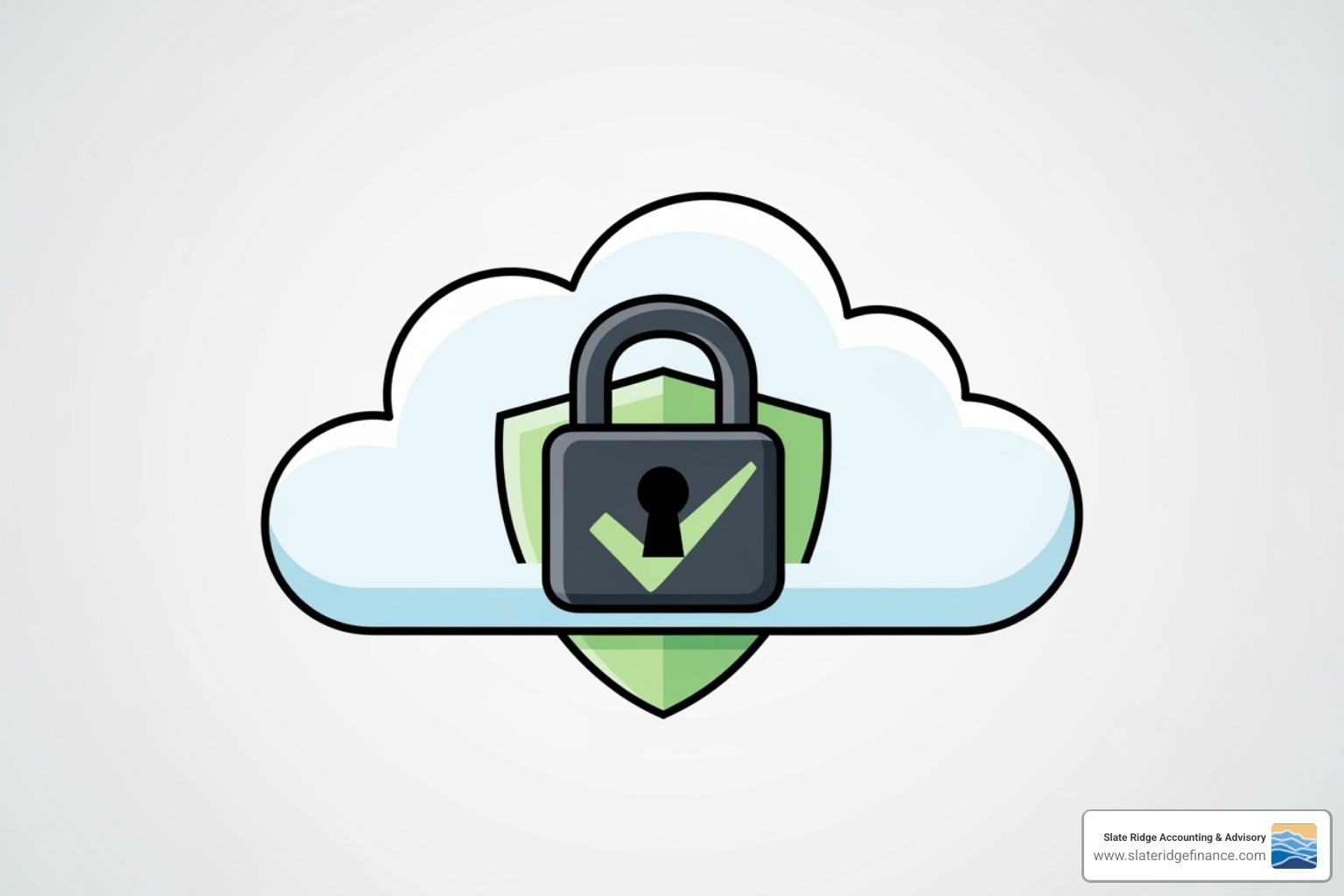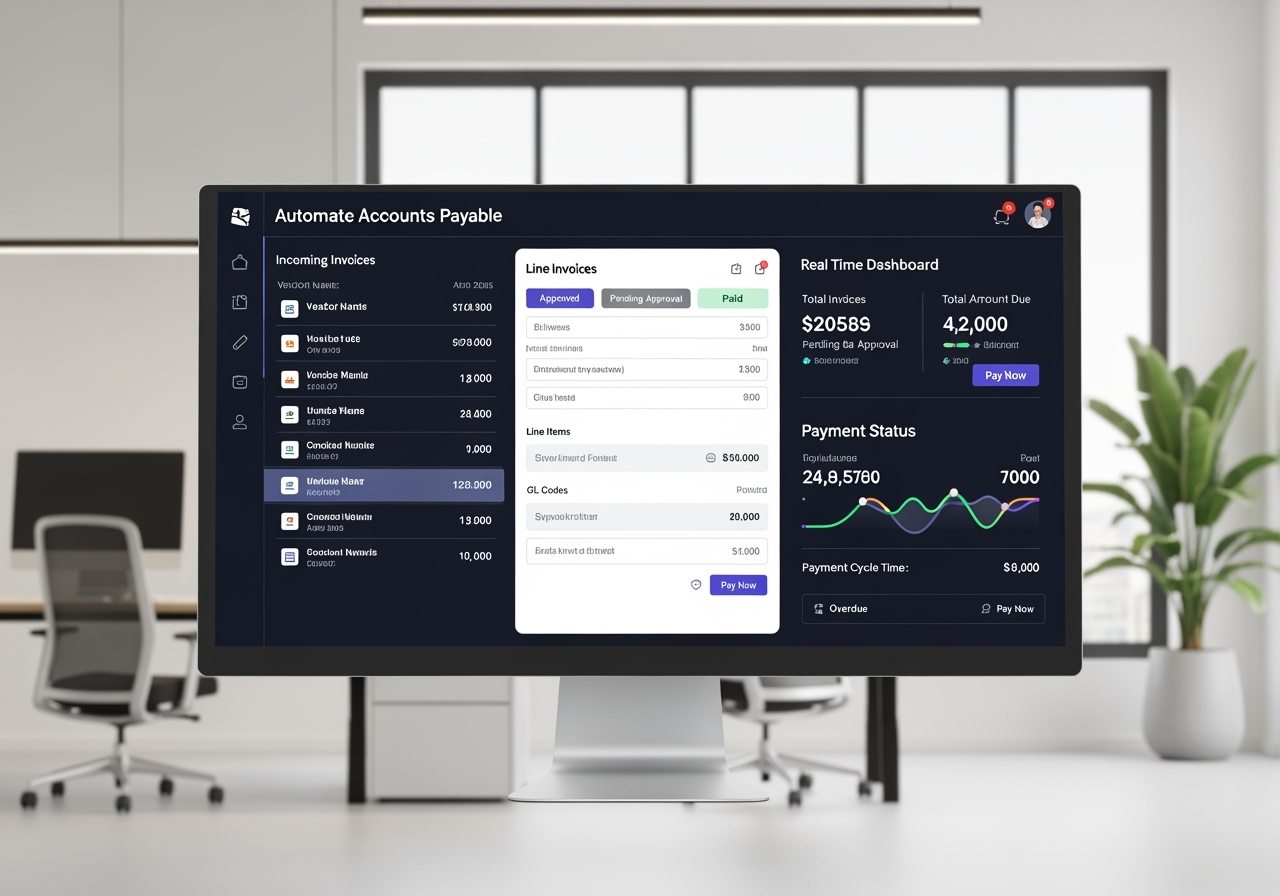Why Modern Businesses Are Moving to Cloud Payroll Management
Cloud payroll management is changing how small and medium businesses handle employee payments by moving payroll processing from local computers to secure internet-based platforms. This shift allows business owners to process payroll from anywhere with an internet connection while reducing costs, improving accuracy, and ensuring compliance.
Key Benefits of Cloud Payroll Management:
- Accessibility: Process payroll from any device, anywhere
- Cost Savings: Up to 40% reduction in payroll processing costs
- Accuracy: 25% increase in payroll accuracy through automation
- Scalability: Easily add employees as your business grows
- Security: Bank-level encryption and automatic compliance updates
- Integration: Seamless connection with accounting and HR systems
The numbers tell the story - the global cloud payroll market was valued at $12.5 billion in 2022 and is projected to reach $25.8 billion by 2030. By 2027, an estimated 70% of all payroll processes will be managed through cloud-based solutions.
Traditional on-premise payroll systems require expensive software installations, regular updates, and dedicated IT support. Cloud payroll eliminates these headaches by handling everything through your web browser. As one business owner put it: "I've gone from zero control to Xero control" - highlighting how cloud solutions actually give you more control, not less.
For overwhelmed business owners juggling multiple responsibilities, cloud payroll offers the promise of automated calculations, error reduction, and the ability to focus on growing your business instead of wrestling with complex payroll tasks.

The Core Benefits of Cloud Payroll Management
Making the switch to cloud payroll management might feel like a big decision, but the benefits speak for themselves. We've seen countless small businesses transform their operations by moving payroll to the cloud, and the results are consistently impressive.
Think of it this way: traditional payroll is like trying to balance your checkbook with a calculator while cloud payroll is like having a financial assistant who never sleeps, never makes math errors, and costs a fraction of what you'd expect.
Improved Efficiency and Accuracy
Remember the last time you had to manually calculate payroll taxes? The double-checking, the worry about getting deductions wrong, the late nights making sure everything balanced? Cloud payroll management eliminates those headaches entirely.
Automated calculations handle everything from complex tax withholdings to overtime calculations with mathematical precision. No more wondering if you remembered to update the state tax rates or worrying about whether you calculated that employee's vacation pay correctly.
The reduction in manual data entry is a game-changer. Instead of typing numbers from timesheets into spreadsheets and then into payroll software, everything flows seamlessly from one system to another. Companies using cloud payroll solutions report a 25% increase in payroll accuracy - that's fewer angry employees asking why their paycheck is wrong and fewer compliance issues keeping you up at night.
Streamlined workflows mean once you enter data, it flows through the entire system automatically. Time tracking connects to payroll calculations, which connect to direct deposits and tax filings. It's like having a perfectly choreographed dance instead of juggling flaming torches.
Significant Cost and Time Savings
Here's where cloud payroll really shines: your wallet will thank you. When you eliminate expensive on-premise hardware, server maintenance, and IT staff, the savings add up quickly. No more paying for software installations, updates, or dealing with compatibility nightmares when your computer decides to update itself.
Cloud payroll solutions can reduce processing costs by up to 40%. That's real money you can reinvest in your business growth strategies instead of spending on technology maintenance.
The time savings are equally impressive. Payroll that used to take hours now takes minutes. One of our clients used to spend an entire day processing payroll for 15 employees - now it's done in under an hour. That's time you can spend on what really matters: growing your business and serving your customers.
For startups especially, this efficiency is crucial when every hour and dollar counts. More info about payroll for startups shows how the right system can make or break early growth phases.
Business agility comes naturally with cloud solutions. As your growing small business adds employees, your payroll system grows with you automatically. No expensive upgrades or system overhauls - just seamless scaling.
| Feature | Traditional Payroll System | Cloud Payroll System |
|---|---|---|
| Cost | High (software, hardware, IT) | Lower (subscription-based, no hardware) |
| Access | Limited (on-site, specific devices) | Anytime, anywhere (web browser, mobile app) |
| Security | Dependent on internal IT | Multi-layered, expert-managed, automatic updates |
| Updates | Manual, costly | Automatic, real-time, compliance-driven |
| Scalability | Complex, expensive | Easy, flexible, adapts to growth |
| Maintenance | High (in-house) | Low (vendor-managed) |
Must-Have Features in a Modern Payroll Solution

Picture this: you're running payroll on a Friday afternoon, and instead of scrambling through spreadsheets and double-checking calculations, you're sipping coffee while your cloud payroll management system handles everything seamlessly. That's the power of choosing the right modern payroll solution.
When we help businesses evaluate payroll systems, we always start with the fundamentals. A great system needs to handle core processing flawlessly, manage complex tax requirements automatically, and provide the kind of reporting that actually helps you understand your business better. But here's what many people don't realize - today's best solutions go far beyond just cutting checks.
The global capabilities of modern payroll systems are particularly exciting. Whether you're a local business planning to expand or already managing employees across different regions, your payroll system should grow with you. For insights on how businesses are navigating this landscape, read our insights on global payroll trends.
Key Features of a Modern Cloud Payroll Management System
Let's talk about what really matters in a payroll system. Automated tax calculations form the backbone of any reliable solution. Your system should handle federal, state, and local taxes without you having to worry about rate changes or new regulations. The best systems update these automatically, so you're always compliant.
Direct deposit isn't just convenient - it's essential for employee satisfaction and operational efficiency. Gone are the days of printing and distributing paper checks. Your employees expect their money to arrive in their accounts reliably and on time.
Pay stubs might seem basic, but modern systems make them accessible online through employee portals. This means fewer interruptions to your day and happier employees who can access their information whenever they need it.
When tax season rolls around, year-end reporting becomes crucial. W-2s, T4s, and other tax forms should generate automatically and be available for electronic filing. This feature alone can save you hours of work and reduce the stress that comes with year-end compliance.
The reporting capabilities separate good payroll systems from great ones. Payroll activity reports give you detailed breakdowns for any pay period, while compliance reports handle tax filings automatically. Leave accrual tracking helps you stay on top of employee time off, and cost center reporting lets you see exactly where your payroll dollars are going across different departments or projects.
General ledger exports ensure your payroll data flows seamlessly into your accounting software, and audit trails provide the transparency you need for compliance and peace of mind.
The Power of Automation, AI, and Employee Self-Service
Here's where modern cloud payroll management gets really exciting. AI-powered anomaly detection acts like a smart assistant, flagging unusual patterns before they become problems. Imagine your system catching an error in overtime calculations or spotting an unusually high deduction before you process payroll.
Automated compliance updates happen behind the scenes, keeping your system current with changing tax laws and regulations. You'll never have to worry about whether you're using the latest rates or following the newest requirements.
Employee self-service portals transform the employee experience. Your team can access their pay stubs, tax documents, and personal information anytime, anywhere. They can submit leave requests and timesheet submissions directly through the system, reducing your administrative workload significantly.
Mobile access means both you and your employees can handle payroll tasks from smartphones or tablets. Whether you're traveling or your employee needs to check their pay stub on the weekend, everything is available at your fingertips.
These features work together to create a payroll system that doesn't just process payments - it actively supports your business operations and helps you make better decisions about your workforce costs.
Security, Compliance, and Seamless Integration

Let's address the elephant in the room: "Is my data really safe in the cloud?" It's a valid concern, especially when you're dealing with sensitive payroll information. The good news is that cloud payroll management systems actually offer better security than most businesses can achieve on their own.
Think about it this way - would you rather store your money under your mattress or in a bank vault? Cloud providers are like bank vaults for your data, with security teams working around the clock to protect it. They have resources and expertise that most small businesses simply can't match.
The beauty of cloud payroll goes beyond just security, though. When your payroll system plays nicely with your other business tools, magic happens. Data flows seamlessly between systems, eliminating those frustrating manual tasks that eat up your valuable time.
Security and Compliance in Cloud Payroll Management
Modern cloud payroll providers take security seriously - and for good reason. Your employee data is their reputation on the line. Data encryption protects your information both when it's traveling between your computer and the cloud servers, and when it's sitting safely stored. Even if someone managed to intercept it, they'd just see gibberish.
Role-based access control means you decide who sees what. Your bookkeeper doesn't need access to salary information for executives, and your managers don't need to see everyone's personal details. It's like having different keys for different rooms in your office.
Here's where cloud payroll really shines: automatic regulatory updates. Tax laws change constantly, and keeping up feels like a full-time job. Cloud systems update themselves automatically, so you're always compliant with the latest HMRC rules for running payroll or other regulatory requirements. No more scrambling to figure out new tax rates or filing deadlines.
Audit trails create a complete record of every action taken in the system. This transparency helps during audits and gives you peace of mind knowing exactly who did what and when. Reputable providers also undergo regular security audits and hold certifications like ISO 27001, proving they meet strict international security standards.
Integrating Payroll with Your Financial Ecosystem
This is where cloud payroll management transforms from a simple tool into a business game-changer. When your payroll system talks to your accounting software, beautiful things happen. No more double-entering data or wondering if your numbers match up.
Connecting with accounting software means your payroll expenses automatically flow into your general ledger. Salary journals, tax liabilities, and benefit costs all post themselves without you lifting a finger. This integration is crucial for maintaining accurate financial records and getting the clear picture you need to make smart business decisions. Our cloud accounting services work seamlessly with these integrated systems.
HRIS integration takes things even further. When HR adds a new employee or updates someone's salary, the payroll system knows instantly. No more playing telephone between departments or finding mismatched information during payroll processing.
The real power comes from having a unified data view across all your systems. Instead of juggling spreadsheets and trying to reconcile different databases, you get one source of truth. This eliminates data silos that create confusion and waste time.
Improved financial planning becomes possible when all your data works together. You can accurately forecast payroll costs, see the real impact of hiring decisions, and make budgets that actually reflect reality. This integration supports more effective virtual financial planning by giving you the reliable data you need to plan for growth.
When everything connects properly, payroll stops being just an administrative task and becomes part of your overall business intelligence. You're not just paying people - you're gaining insights that help drive your business forward.
How to Choose and Migrate to a Cloud Payroll System
Making the leap to cloud payroll management doesn't have to feel overwhelming. With the right approach and careful planning, you can transform what seems like a daunting process into a smooth transition that sets your business up for success. We've helped countless businesses steer this journey, and we're here to share what we've learned along the way.
Think of choosing a cloud payroll system like finding the perfect business partner – you want someone reliable, affordable, and ready to grow with you. The good news? Once you know what to look for, the decision becomes much clearer.
Evaluating Pricing and Finding the Right Fit
When it comes to pricing, cloud payroll services typically follow two main models. The per-employee per-month approach charges a base fee plus an amount for each active employee – perfect for businesses that want predictable scaling costs. Alternatively, tiered subscription plans offer different feature sets at various price points, usually including a specific number of employees with options to upgrade as you grow.
Here's where things get tricky: the advertised price isn't always the full story. Smart business owners dig deeper to uncover potential hidden costs. Setup fees can catch you off guard, as can charges for additional pay runs beyond your standard schedule. Year-end tax form filing fees might seem small until you're facing them annually, and support costs can add up if they're not included in your base plan.
The scalability of plans deserves special attention. You want a system that celebrates your growth, not penalizes it. Look for providers that make it easy to add employees or upgrade features without forcing you to start from scratch with a new system entirely.
Before you fall in love with any particular solution, take an honest look at your business needs. Consider your current and projected employee count – if you're planning to double your team in the next year, factor that into your decision. Think about your payroll complexity too. Do you manage hourly workers, salaried employees, or contractors? What about commissions, bonuses, or industry-specific requirements like union deductions?
Don't forget about integration needs. Your payroll system should play nicely with your existing accounting software, time tracking tools, and HR systems. For businesses looking to streamline their entire financial ecosystem, comprehensive solutions that combine payroll with other services like our bookkeeping services for small businesses can be game-changers.
For more detailed guidance on making this crucial decision, check out a guide to choosing the right system.
Best Practices for a Smooth Migration
Once you've selected your ideal cloud payroll management system, the migration phase begins. This is where careful planning pays dividends, turning what could be a stressful transition into a well-orchestrated upgrade.
Data cleanup and validation is your foundation for success. Before you even think about migrating, roll up your sleeves and get your existing payroll data in pristine condition. Ensure every employee record is accurate, historical pay data is complete, and tax details are up-to-date. Think of this as spring cleaning for your payroll – it might take some effort upfront, but starting with clean data prevents headaches down the road.
When it comes to implementation strategy, you have two main paths. Phased rollouts work well for larger or more complex operations, allowing you to migrate specific departments or run parallel systems for a period. All-at-once migrations can be perfect for smaller businesses ready to make a complete switch. Choose the approach that matches your comfort level and operational complexity.
Your communication plan can make or break employee acceptance of the new system. Keep your team informed about why you're making the change, what benefits they'll see (hello, employee self-service portals!), and exactly what they need to do. Clear, friendly communication prevents confusion and builds excitement about the improvements coming their way.
Team training is an investment that pays immediate returns. Most cloud providers offer comprehensive training resources, webinars, and dedicated support during implementation. The more confident your payroll and HR teams feel with the new system, the smoother your daily operations will be from day one.
Don't underestimate the value of post-launch support. Even with perfect planning, questions will arise after you go live. Ensure you have access to responsive customer support and establish clear internal processes for handling employee inquiries. This preparation turns minor hiccups into quick wins.
For more complex migrations or if you prefer expert guidance, consider choosing an implementation partner. Many cloud payroll providers work with certified partners who specialize in smooth transitions. These professionals can ensure data integrity and optimize your system configuration for your specific business needs.
This migration isn't just about changing software – it's about upgrading how your business operates. With thoughtful planning and the right support, you'll wonder why you waited so long to make the switch.
Frequently Asked Questions about Cloud Payroll
We get it - moving your payroll to the cloud can feel like a big step. That's why we love sitting down with business owners to answer their questions and ease any concerns. Here are the three questions that come up in almost every conversation we have about cloud payroll management.
How does cloud payroll software handle tax compliance?
Here's where cloud payroll really shines, and frankly, where it can save you from some serious headaches. The beauty of cloud-based systems is that they're constantly talking to the tax authorities, so to speak.
Automatic updates happen behind the scenes - no action required from you. When the IRS changes tax brackets or your state adjusts withholding rates, your system already knows about it. This means your federal, state, and local tax calculations are always current, eliminating those "oops, I didn't know the rate changed" moments that can cost you penalties.
The e-filing capabilities are a game-changer too. Instead of printing forms, stuffing envelopes, and hoping they arrive on time, your W-2s and quarterly returns get filed electronically. It's faster, more reliable, and you get confirmation that everything was received.
What really gives us peace of mind is how these systems reduce the risk of non-compliance penalties. They're essentially your compliance watchdog, alerting you to issues before they become expensive problems.
Is my company's data safe in the cloud?
This is probably the question we hear most often, and honestly, we understand the concern. You're trusting someone else with your most sensitive business information.
Here's what might surprise you: your data is likely safer in the cloud than on your office computer. Think about it - cloud providers invest millions in security infrastructure that would be impossible for most small businesses to afford. They have multi-layered security systems, with experts monitoring them 24/7.
Data encryption means your information is scrambled during transmission and storage, making it unreadable to anyone who shouldn't have access. It's like having your data locked in a vault that only authorized people can open.
The regular security audits are reassuring too. Reputable provider certifications like ISO 27001 aren't just fancy certificates on the wall - they represent rigorous testing and validation of security practices. These companies literally make their living by keeping your data safe.
While no system is perfect, cloud providers generally have far better security than what most of us could set up in our own offices. Plus, they handle all the updates and monitoring, so you don't have to become a cybersecurity expert overnight.
Can cloud payroll grow with my small business?
Absolutely, and this is one of our favorite aspects of cloud payroll management. We've seen too many businesses outgrow their systems and face the nightmare of switching providers mid-growth spurt.
Cloud payroll is built for growth. Scalable pricing plans mean you're not locked into paying for 100 employees when you only have 10. As you hire, you simply add employees easily to the system - no new software to buy or servers to upgrade.
What's really exciting is how you can access more advanced features as needed. Maybe you start with basic payroll processing, but as your business grows, you might want sophisticated reporting or multi-location capabilities. With cloud payroll, these features are often just an upgrade away within the same system.
This supports business growth without needing to switch systems entirely. We've worked with clients who started as solo entrepreneurs and grew to 50+ employees, all while using the same cloud payroll platform. The system grew with them, adapting to their changing needs without missing a beat.
The flexibility means your payroll never becomes a bottleneck to growth - and that's exactly how it should be.
Conclusion
The journey through cloud payroll management reveals a powerful truth: this isn't just about switching software—it's about changing how your business operates. When you move your payroll to the cloud, you're choosing freedom over frustration, accuracy over anxiety, and growth over getting stuck in administrative quicksand.
Think about where we started. Remember those late nights wrestling with payroll calculations? The stress of wondering if you missed a tax update? The frustration of employees asking for their pay stubs while you're trying to focus on serving customers? Cloud payroll eliminates these pain points entirely.
The numbers speak for themselves: up to 40% cost reduction, 25% increase in accuracy, and countless hours returned to your week. But beyond the statistics lies something more valuable—peace of mind. When your payroll runs itself with automated calculations, secure data protection, and seamless integration with your accounting systems, you can sleep better knowing everything is handled correctly.
At Slate Ridge Accounting & Advisory, we've seen how cloud payroll transforms small businesses. It's not just about paying employees; it's about creating reliable financial data that helps us provide better virtual accounting services and strategic guidance. When your payroll data flows seamlessly into your financial ecosystem, we can help you track KPIs and forecast growth with unprecedented accuracy.
The future belongs to businesses that accept smart, cloud-based solutions. Cloud payroll management isn't coming—it's here, and it's already helping thousands of small businesses operate more efficiently. Your employees get instant access to their pay information, you get back hours of your life each week, and your business gets the solid financial foundation it needs to thrive.
Ready to join the cloud payroll revolution? Your future self—the one who's not stressed about payroll every two weeks—will thank you for making this move today.
Ready to get started?
Book a free consultation today and let’s explore how Slate Ridge can support your business with expert accounting that’s accurate, timely, and built around your goals.



_compressed.jpeg)


